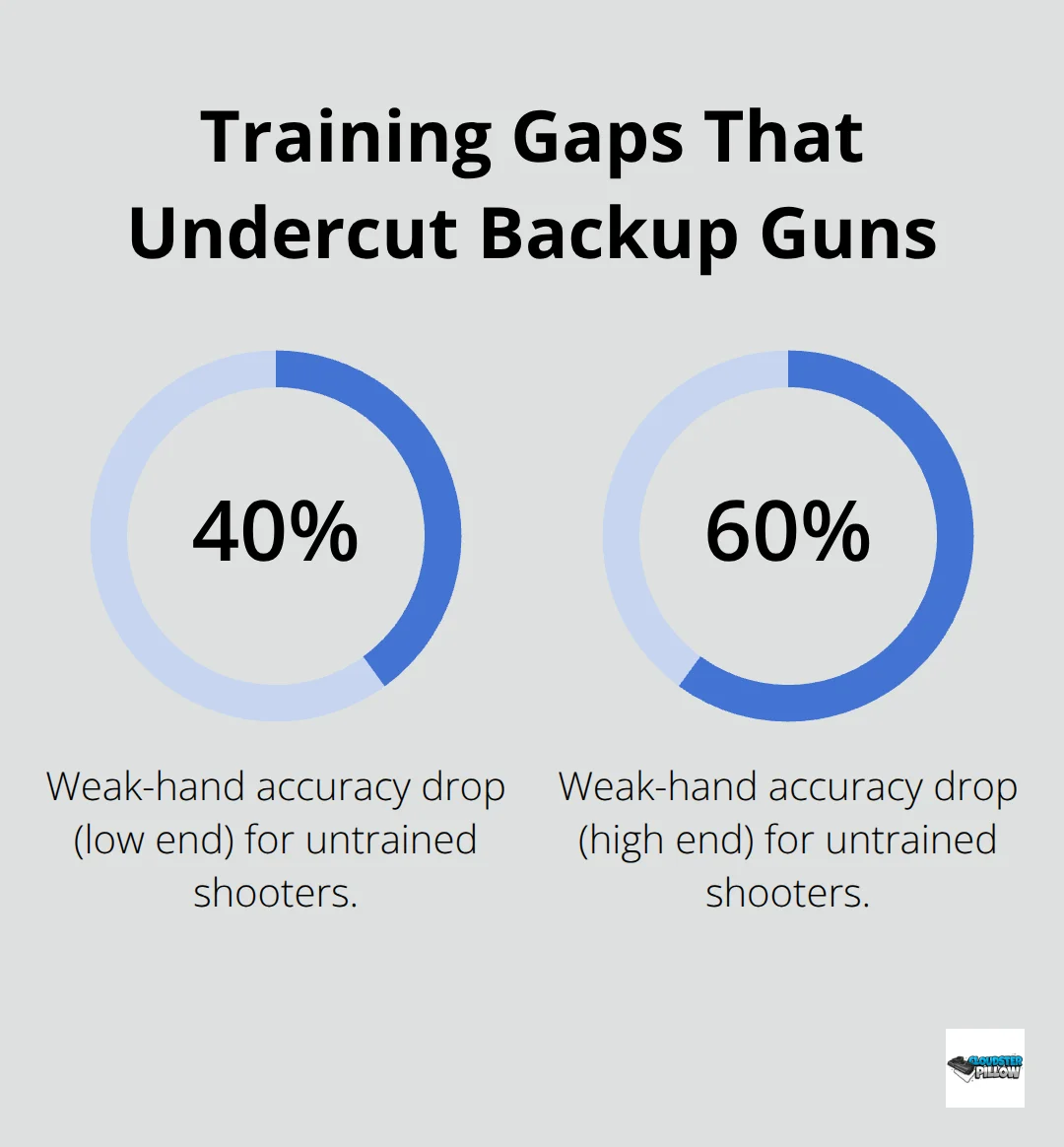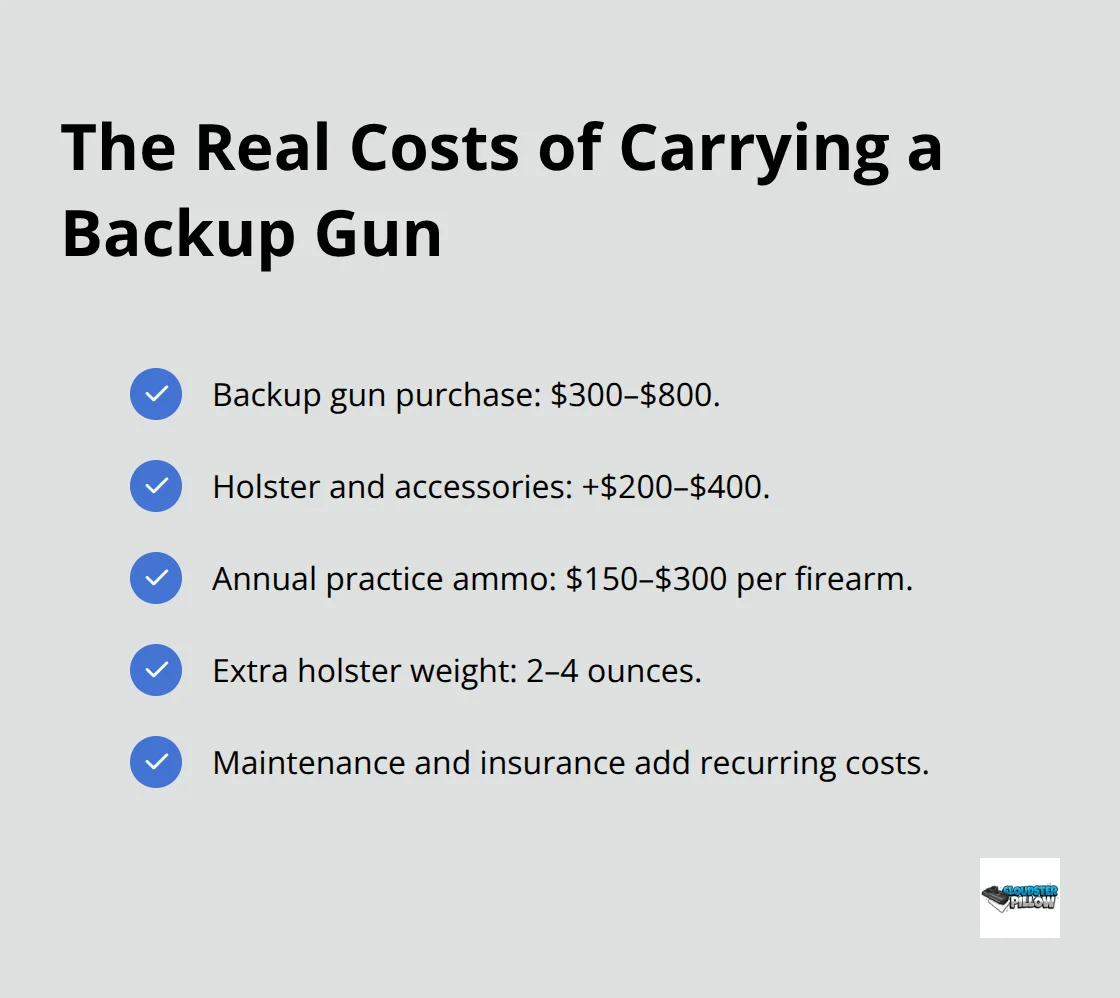Holsters and Gear Recommendations, Firearm Tips and Tricks, Firearms, Firearms Training
Should You Carry a Backup Gun for Concealed Carry?
The backup gun debate splits the concealed carry community down the middle. Some swear by carrying two firearms, while others call it unnecessary weight and complication.
We at Cloudster Pillow see this question come up constantly among carriers trying to build their perfect setup. The answer isn’t black and white – it depends on your specific situation, training level, and carry goals.
Why Do Some Carriers Choose Backup Guns?
Firearm malfunctions strike at the worst possible moments. When your primary weapon jams during a critical incident, that percentage becomes 100% for you. Double-feed malfunctions, broken firing pins, and magazine failures can render even the most reliable pistol useless. A backup gun eliminates this single point of failure completely.
When Primary Weapons Fail
Modern pistols rarely malfunction, but they’re not bulletproof. Glock pistols experience failure rates around 1 in 10,000 rounds under normal conditions, yet stress and poor maintenance can increase these numbers dramatically. Police departments like the NYPD have documented cases where officers needed backup weapons after primary firearm failures occurred during shootouts. The Smith & Wesson J-Frame revolver remains popular among law enforcement as a backup precisely because revolvers have fewer parts that can fail. Your backup gun should use different ammunition than your primary weapon to avoid systemic failures from bad ammo batches.

Multiple Attackers and Extended Encounters
Studies consistently show significant numbers of defensive gun uses occur annually. Your primary weapon might hold 15 rounds, but stress makes reloads take precious seconds that attackers can exploit. A backup gun provides immediate firepower when your primary runs dry. The 2019 Dayton incident showed how quickly situations can escalate – police neutralized the threat in 32 seconds, but multiple weapons would have provided more options. Ankle-carried backup guns offer access when your strong-side holster becomes compromised or when you’re on the ground.
Strategic Carry Positions
Different situations demand different carry methods. Your appendix-carried primary might print badly when you sit, which makes a pocket-carried backup more accessible. Off-duty police officers often carry primary weapons at 4 o’clock but keep backup guns in ankle holsters for seated positions. The KelTec P32 weighs just 6.9 ounces, making it ideal for deep concealment when your primary gun would be too obvious.
These benefits sound compelling, but backup guns also create new challenges that many carriers don’t anticipate.
What Are the Real Costs of Backup Guns?
Two firearms transform your entire carry system into something heavier and more complex than most carriers expect. The average backup gun adds 12-16 ounces to your daily load, plus another holster that weighs 2-4 ounces. The Ruger LCP weighs 9.6 ounces unloaded, but with ammunition and a pocket holster, you carry nearly a full pound of extra gear. Your belt, pants, and holster setup must accommodate this additional weight without prints or sags.
Weight Distribution Problems
Extra weight creates balance issues that affect your natural movement. Ankle holsters pull down on your leg with each step, while pocket guns create obvious bulges in dress pants. The Smith & Wesson J-Frame weighs 14.4 ounces empty – add five rounds and a holster, and you approach 20 ounces of dead weight on one side of your body.
Your existing carry setup worked fine with one gun, but two weapons stress belts and clothing beyond their limits. Quality gun belts are designed to accommodate the weight of your gun and holster system.
Training Demands Double
Two different firearms require separate muscle memory for each weapon. Police departments mandate 40-60 hours annually for primary weapon practice, but backup gun proficiency demands additional range time that most civilians skip. A good general goal is 2.00 seconds to react, draw, and fire for one hit at 5 yards.
Weak-hand accuracy drops 40-60% for untrained shooters, which makes backup guns potentially useless without dedicated practice. Each firearm needs different grip techniques, sight pictures, and manual of arms that your brain must process under extreme stress. Most carriers practice with their primary weapon but neglect backup gun drills entirely.

Financial Reality Check
Quality backup guns cost $300-800, plus holsters, ammunition, and accessories that easily add another $200-400. The Kahr CW380 runs $419, while a decent pocket holster costs $60-80. Annual ammunition for practice costs $150-300 per firearm, which doubles your training budget.

Maintenance schedules multiply – two guns need separate cleanings, spring replacements, and potential repairs. Insurance coverage may require policy adjustments for additional firearms (check with your provider first). Most carriers underestimate these costs, focus only on initial purchase prices, and ignore the long-term financial commitment of multiple weapon proficiency.
These financial and practical challenges lead many experienced carriers to explore simpler alternatives that deliver similar benefits without the complexity.
What Simple Solutions Beat Backup Guns?
Smart carriers solve capacity and reliability concerns without doubling their gear load. Extra magazines cost $30-50 compared to $400-800 backup guns, yet they address the same core problems that drive people toward second firearms. A spare 15-round magazine for your Glock 19 provides more ammunition than most backup guns hold, weighs just 4.2 ounces loaded, and requires zero additional training since you already know your primary weapon’s manual of arms.
Magazine Solutions Work Better Than Second Guns
Malfunction clearance becomes faster with spare magazines than drawing backup weapons. Tap-rack-bang drills take 1.5-2 seconds with practice, while accessing ankle or pocket backup guns requires 3-4 seconds minimum. Proper magazine changes address most firearm reliability issues, which makes spare ammunition more practical than additional firearms. Speed loaders for revolvers cost $15-25 and provide similar benefits – the HKS speedloader holds six rounds and weighs 1.8 ounces (dramatically less than any backup pistol).
Training Beats Additional Hardware Every Time
Situational awareness prevents more confrontations than backup guns ever could. Better route planning and environmental scanning reduce threats more effectively than carrying extra firearms. Professional instruction costs $200-400 but delivers permanent skills that work with any weapon system.
Defensive shooting courses teach multiple target engagement, weak-hand shooting, and malfunction clearance – exactly the skills that backup gun advocates claim their second weapon provides. Your existing pistol becomes far more effective with 40 hours of quality training than adding untrained backup weapons ever could.
Choose Better Primary Weapons Instead
Higher capacity primary firearms eliminate most arguments for backup guns entirely. The SIG P365 holds 12+1 rounds in a package smaller than many backup guns, while extended magazines boost capacity to 15 rounds without printing issues. Reliability improvements in modern striker-fired pistols make backup weapons largely unnecessary – Glock torture tests show 50,000+ round counts without failures when properly maintained (assuming regular cleaning and quality ammunition).
Your carry system becomes simpler and more effective when you upgrade your primary weapon rather than add complexity through multiple firearms. Modern compact pistols offer the capacity and reliability that once required backup guns to achieve.
Final Thoughts
The backup gun decision requires honest self-assessment rather than gear collection. Most civilian carriers face different threat profiles than law enforcement officers who originally popularized backup weapons. Your daily routine, training commitment, and physical limitations matter more than theoretical scenarios.
Training with your primary weapon delivers better results than carrying untrained backup firearms. The 16 million Americans with concealed carry permits would benefit more from additional range time than additional hardware. Quality instruction costs less than a backup gun while providing skills that work in every situation.
Your carry setup should prioritize comfort and consistency over complexity. A reliable primary weapon with spare ammunition handles 99% of defensive scenarios without the weight penalties or training demands of multiple firearms. Modern compact pistols offer the capacity and reliability that once required backup weapons to achieve. We at Cloudster Pillow help carriers achieve that comfort through our holster wedge collection designed for all-day concealment without replacing your entire system.


